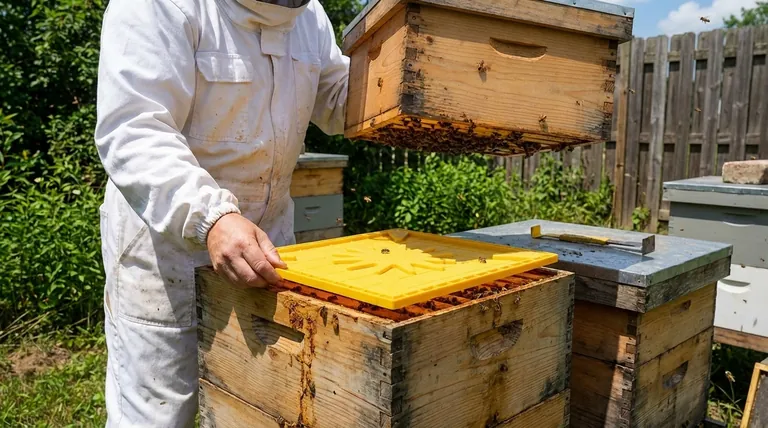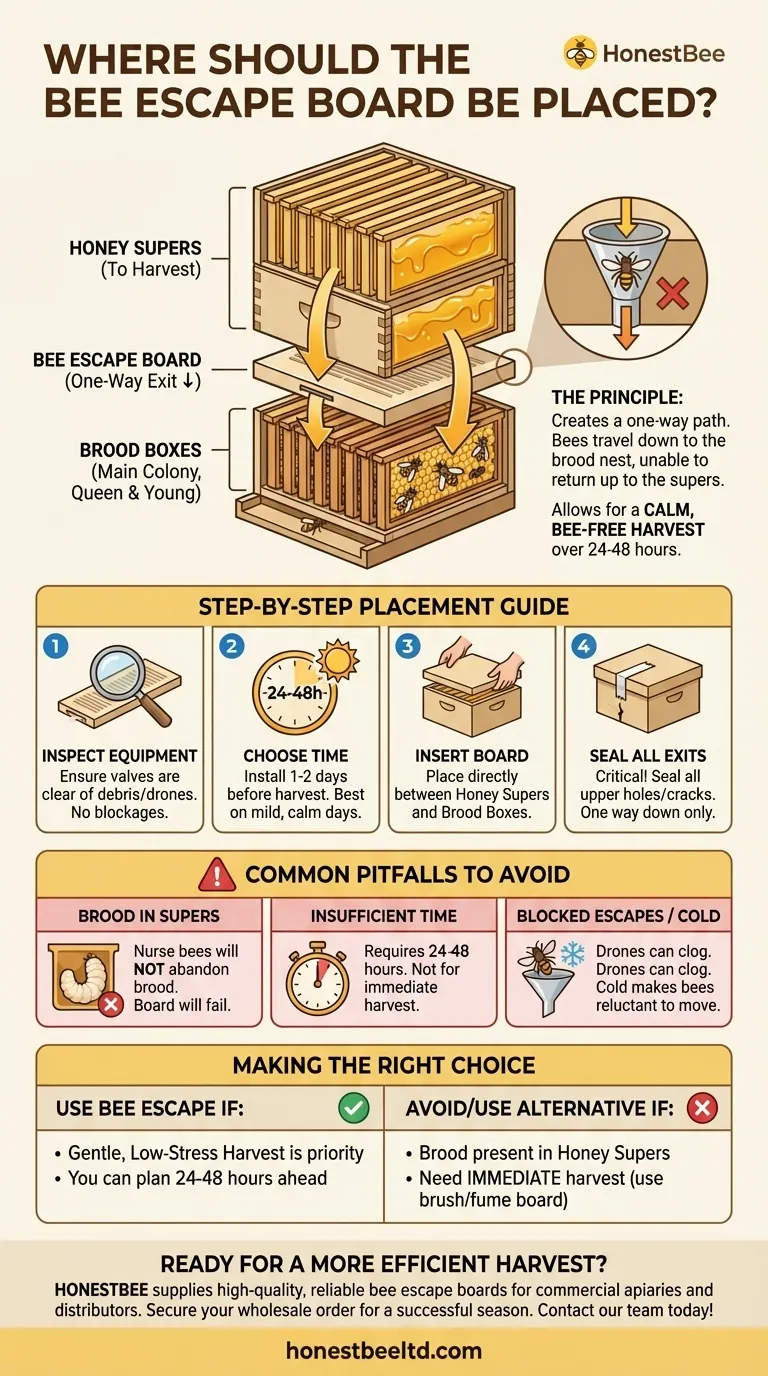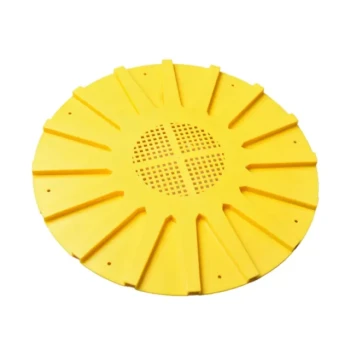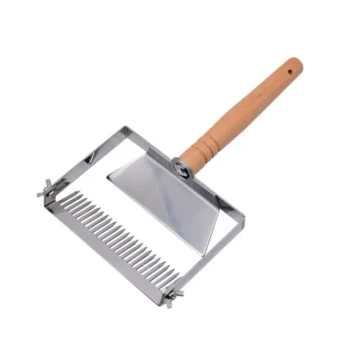To clear your honey supers for harvest, the bee escape board must be placed directly between the honey supers you intend to harvest and the main brood boxes below. This placement creates a one-way exit for the bees. It allows them to move down into the brood chamber to be with the queen and the young, but the design of the escape prevents them from traveling back up into the supers.
The core principle is simple: the bee escape board is a tool for gently separating the bees from the honey. Its correct placement is the critical first step to a calm, methodical, and stress-free harvest for both the beekeeper and the colony.

The Principle Behind the Bee Escape
How a Bee Escape Board Works
A bee escape board is essentially an inner cover fitted with one or more one-way valves or mazes. Forager bees in the honey supers naturally travel down into the brood nest, especially overnight. The escape funnels allow them to pass through easily in one direction.
When they attempt to return to the supers to tend to the honey, the design of the escape prevents them from finding the entrance. Over a period of 24 to 48 hours, this simple mechanism will quietly and effectively clear the vast majority of bees from the honey supers.
The Goal: A Calm and Bee-Free Harvest
Using a bee escape is one of the most passive and gentle methods for clearing honey supers. It avoids the agitation caused by more forceful methods like using a bee brush or a fume board.
A calm colony is safer to work with and reduces the risk of defensive behavior. This method also minimizes the chances of initiating robbing from other nearby hives, as the hive remains sealed while the bees are moved.
Step-by-Step Guide to Placement
Step 1: Inspect Your Equipment
Before you begin, ensure your bee escape board is ready. Check that the escape valves are clear of debris, wax, or propolis. Also, ensure no drones are stuck inside from a previous use, as this will block the exit for other bees.
Step 2: Choose the Right Time
Plan to install the board 24 to 48 hours before you intend to collect the honey. This window gives the bees enough time to move down into the brood box. It is best to do this on a calm, mild day to minimize disruption to the hive.
Step 3: Insert the Board
Briefly smoke the hive entrance and under the top cover. Working quickly, remove the honey supers you plan to harvest, keeping them together as a single unit if possible.
Place the bee escape board directly on top of the uppermost brood box (or the highest super you are not harvesting). Finally, place the honey supers to be harvested back on top of the escape board.
Step 4: Seal All Other Exits
This is a critical step. For the board to work, the one-way valve must be the only way for bees to travel between the brood box and the supers.
Ensure there are no other upper entrances, cracks, or holes in the supers above the escape board. If bees can fly out and re-enter from the outside, the supers will not be cleared. Use tape to temporarily seal any gaps.
Common Pitfalls to Avoid
Brood in the Honey Supers
The bee escape board will fail if there is brood (eggs or larvae) in the honey supers. Nurse bees are biologically programmed to care for the young and will not abandon them.
To avoid this, it is standard practice to use a queen excluder earlier in the season. A queen excluder prevents the larger queen from moving into the supers to lay eggs, ensuring they are used only for honey storage.
The Time Requirement
The most significant trade-off is time. This is not an instant solution. It requires a dedicated trip to the apiary to install the board and another trip a day or two later to collect the cleared supers. Beekeepers who need to harvest immediately must use other methods.
Blocked Escapes or Poor Weather
Occasionally, large drones can get stuck in the escapes, clogging the exit for other bees. Furthermore, a sudden drop in temperature can make bees reluctant to move down and away from the warmth of their cluster, potentially trapping them in the cold supers. This method works best during stable, mild weather.
Making the Right Choice for Your Harvest
By understanding the purpose and process, you can determine if this tool is right for your situation.
- If your primary focus is a gentle, low-stress harvest: The bee escape board is the ideal method, provided you plan 24-48 hours ahead.
- If you have brood in your honey supers: Do not use a bee escape board, as it will be ineffective. You will need to brush bees off each frame individually.
- If your primary focus is harvesting immediately: This method is not suitable. You will need to use a more active removal technique, such as a bee brush or fume board.
Properly used, the bee escape board is an invaluable tool for a peaceful and efficient harvest.
Summary Table:
| Step | Key Action | Purpose |
|---|---|---|
| 1 | Inspect Equipment | Ensure escape valves are clear and functional. |
| 2 | Choose Timing | Install 24-48 hours before harvest on a mild day. |
| 3 | Insert Board | Place between honey supers and brood box below. |
| 4 | Seal Other Exits | Prevent bees from re-entering supers from outside. |
Ready for a more efficient and gentle harvest? HONESTBEE supplies commercial apiaries and beekeeping equipment distributors with high-quality, reliable bee escape boards and other essential tools. Our wholesale-focused operations ensure you get the durable equipment you need for a successful season. Contact our team today to discuss your supply needs and elevate your beekeeping operation.
Visual Guide

Related Products
- HONESTBEE Multi Exit Plastic Bee Escape Board for Efficient Honey Harvesting
- High-Efficiency Diamond Maze Bee Escape for Clearing Supers
- Efficient Hive Clearing: HONESTBEE 8-Way Plastic Bee Escape
- Durable 16 Way Circular Bee Escape for Efficient Honey Harvesting
- Professional Durable Two-Piece Plastic Bee Escape
People Also Ask
- What is the method of separating bees from honey supers using the Bee Escape Board? A Gentle, Low-Stress Harvesting Guide
- How is the Triangle Bee Escape Board placed when removing a super? Master the Correct Placement for a Stress-Free Harvest
- What is an escape board used for? A Gentle, Chemical-Free Honey Harvest
- What is the result of using a bee escape board for 24 hours? Achieve a Near Bee-Free Honey Super
- How should bee escape boards be used for optimal results? A Guide to a Calm, Efficient Honey Harvest



















